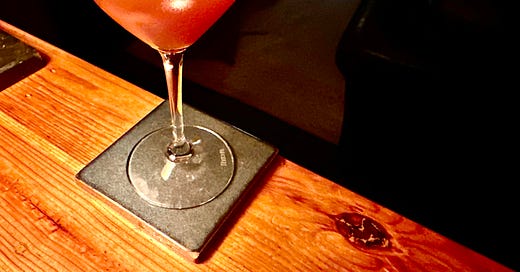A Pair of Bittered Honey Daiquiris From One of the World’s Best Bars
Two simple-yet-delicious four-ingredient warm-weather cocktails from Attaboy.
This is a newsletter about home bartending. It’s focused on home bartending because I believe that it’s possible, with a modest amount of effort, for home bartenders to execute world-class cocktails in their own kitchens. It’s also focused on home bartending because it was by making drinks at home that I really learned to understand and appreciate cocktails.
At the same time, I first became entranced by the magic of cocktails by going to good cocktail bars. Specifically, in fact, at one bar — the original Columbia Room in Washington, D.C.
When I first visited the Columbia Room, sometime around 2010, it was hidden behind an unmarked door in the back of a sort of neo-cocktail dive, The Passenger, which still exists but is now in a different location.
Visiting the Columbia Room was an experience — you were greeted at the unmarked door, then brought through an atrium and then into the bar space. Unlike the noisy dive outside, the Columbia Room was small and hushed, exuding a kind of focus and purpose I was unused to at the time, when speakeasy aesthetics were relatively novel.
So I was taken with the vibe. But what really got me were the drinks.
The cocktails at the Columbia Room seemed like magic tricks. Like they couldn’t possibly be real, except there they were.
Eventually, after the Columbia Room moved to a new location, the bar was awarded one of the cocktail world’s top honors — the “Best American Cocktai Bar” award at Tales of the Cocktail in 2017. (The Columbia Room is closed now, and at some point this year will be replaced by a D.C. outpost of Death & Company.)1 But the point is: I wasn’t the only one who was impressed with the drinks. They were genuinely special, especially in the early days.
Because the drinks seemed so perfect and so mysterious, and because I was so new to the world of cocktails, I assumed I could never make them myself. And then, of course, I spent the next decade or so attempting to learn just that.
For the most part, that’s meant working through a lot of recipes, a lot of cocktail books, and a lot of ingredients at home. But I still like to go to great cocktail bars when I can. Not only am I lucky enough to live in Washington, D.C., which is a great cocktail city, I also make somewhat frequent trips to New York, the epicenter of the American cocktail scene. And when I do, I almost always try to make it to at least one influential or notable cocktail bar.
These days, the drinks usually don’t seem quite as much like magic tricks — or, to the extent they do, they seem like tricks where I can see the sleight of hand.
But I go to these bars because I still love the drinks, still love being wowed by something novel and clever and delicious. The mystery might have faded, but I still appreciate the application of craftsmanship and technique.
Also, I also go to try to study what these bars are doing in hopes of learning something I can take home.
And every now and then, a bar still manages to recreate that magic — not so much in the sense that I can’t see the trick at all, but in the sense that it all comes together in a perfect, seamless package.
So it was with a pair of recent visits to Attaboy in New York.
For those who don’t know its reputation, Attaboy is located in the former home of one of the craft cocktail revolution’s most important bars, Milk and Honey. Attaboy is now one of the most highly regarded bars in the world: In 2022, it was ranked the best bar in North America by the influential 50 Best Bars list; this year it slipped to number 13, almost certainly as a result of shifts in the competition. In any case, I am here to tell you that whether it’s the best bar on the continent or merely the 13th best, it’s a very, very good bar, deserving of all the accolades.
It’s also a bar that has a clear and distinctive style built on incredibly clever but relatively simple-to-execute drinks made in a shockingly small space — the sort of cocktails, in other words, that sharp home bartenders can learn from and in many cases replicate at home.
For this week’s newsletter then, I want to offer a brief overview of Attaboy’s approach to cocktails and its relatively unique ordering system. And then we’ll continue our series on bittered sours by looking at a pair of easy-to-make, four-ingredient, bittered honey Daiquiri riffs both of which were created at the bar.



